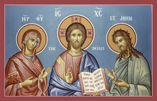|
The
Deisis
The term means supplication or intercession. Most often shown with the Virgin on the left (Christ’s ‘right hand’) and John the Baptist on the right. The heads of the Virgin Mary and St. John are slightly bowed in humility with their hands outstretched toward Christ in petition. Their haloes are gold symbolizing the divine light of Christ that is part of them and radiates from them.  Larger Image Christ is shown in the variant pantocrator (Lord of All) style with an open book (often called Christ the Teacher). His right hand is in the distinct shape of the letter ICXC used to give a blessing. Christ’s halo as a cross to allude to the Trinity. Christ wears red (martrydom and resurrection) covered with blue (spirituality and heaven) showing that his earthly nature and existence (red) was secondary to his Divine nature (blue). The colors of Mary (Theotokos or ‘God bearer’) are reversed from that of Christ: her human existence (red) came first before her spiritual/heavenly life. Three stars on her (head and shoulders) reveal that she was a virgin before, during and after the nativity. John the Baptist has the disordered hair showing his life of penitence in the desert and is clad in a green robe (life and hope).   |